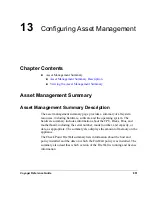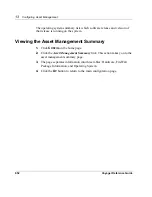
12
Configuring SNMP
648
Voyager Reference Guide
The range is 0-65535. There is no default.
5.
Enter the name of the user’s home directory in the
H
OME
DIRECTORY
edit
box. Enter the full Unix path name of the directory where the user will be
placed after login. If the home directory does not exist, the system will
create it.
6.
Click
A
PPLY
.
7.
An entry for the new user and his/her profile appears. The default shell is
/bin/csh. The default page refers to the user’s default page when he/she
logs in. The default page is set to the home page.
8.
(Optional) To modify the shell, enter the new shell path name in the
S
HELL
edit box.
Consult the file /etc/shells for valid login shells.
9.
(Optional) To modify the default page, enter the name of the new default
page in the
D
EFAULT
PAGE
edit box.
10.
Enter the new user’s password in the
N
EW
PASSWORD
edit box. Leave
the
O
LD
PASSWORD
edit box empty.
11.
Enter the same password that you entered in the
N
EW
PASSWORD
edit
box in the
N
EW
PASSWORD
(
VERIFY
)
edit box.
Note
The password of an SNMP USM user must be at least 8 characters long.
12.
Click
A
PPLY
, and then click
S
AVE
to make your changes permanent.
Note
A table appears on the SNMP page with the name of each user and his/
her permissions.
Summary of Contents for Network Voyager
Page 1: ...Voyager Reference Guide Part No N450820002 Rev A Published December 2003 ...
Page 4: ...4 Voyager Reference Guide ...
Page 30: ...2 How to Use Voyager 30 Voyager Reference Guide ...
Page 32: ...3 Command Line Utility Files 32 Voyager Reference Guide ...
Page 220: ...5 Configuring Interfaces 220 Voyager Reference Guide ...
Page 446: ...7 Configuring Traffic Management 448 Voyager Reference Guide ...
Page 618: ...10 Configuring Security and Access 620 Voyager Reference Guide ...
Page 668: ...14 Configuring IPv6 670 Voyager Reference Guide ...
Page 672: ...15 IPSO Process Management 674 Voyager Reference Guide ...
Page 700: ...Index 702 Voyager Reference Guide ...
















































